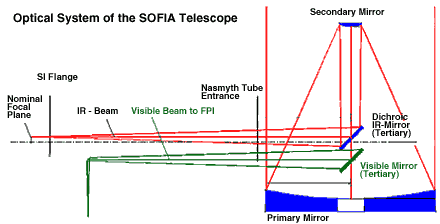Under an agreement with NASA, DLR (the German Aerospace Center) supplied the telescope for the SOFIA observatory, as well as operation support, in exchange for observation time aboard the SOFIA.
The SOFIA telescope consisted of a parabolic 2.7m (2.5m effective diameter) primary mirror and a hyperbolic secondary mirror in a bent Cassegrain configuration with two Nasmyth foci, the nominal IR focus and an additional visible light focus for guiding. The secondary mirror was attached to a chopping mechanism providing chop amplitudes of up to ± 5 arcmin at chop frequencies between 0 and 20 Hz, programmable by either a user supplied analogue or TTL curve or by the telescope control electronics. A flat tertiary mirror reflected the IR beam into the infrared Nasmyth focus, 300mm behind the instrument flange. If the fully reflecting tertiary was replaced with a dichroic mirror, the transmitted optical light was reflected by a second tertiary 289.2mm behind the dichroic and sent to the visible Nasmyth focus. There it was fed into the Focal Plane Imager (FPI), an optical focal plane guiding camera system. Independent of the FPI there were two other imaging and guiding cameras available: the Wide Field Imager (WFI) and the Fine Field Imager (FFI). Both of these cameras were attached to the front ring of the telescope.
For more information about the telescope, see the SOFIA technical brochure .
For more information about the SOFIA instrument suite, see the ApJL SOFIA Special Issue .
